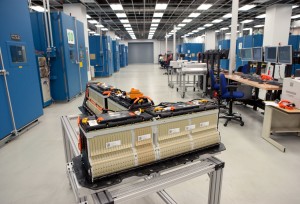Electric cars may run clean. But how green is the battery?
Hi, this is Steven Cherry for IEEE Spectrum's "This Week in Technology."
With governments around the world investing heavily in electric and hybrid cars, the demand for the batteries that power these vehicles is on the rise. The United States alone has invested $2.4 billion to ramp up production, and the first wave of lithium-ion car batteries is just now hitting the market.
By 2014, the U.S. could be making a half million batteries a year. Battery-powered cars emit fewer pollutants and greenhouse gases. That's the point.
But some critics have wondered: Just how green are the batteries themselves? Where does that soft silvery metal, lithium, come from? What goes into making it into a battery? And just what is its impact compared to that of a traditional combustion engine?
My guest today is Dominic Notter, a researcher for the Swiss Federal Laboratories for Materials Science and Technology. He joins us by phone from his office in Duebendorf, Switzerland. Dominic, welcome to the podcast.
Dominic Notter: You're welcome.
Steven Cherry: So maybe you can tell us what your research found: How green is a lithium-ion battery, and how does that compare to a regular combustion engine?
Dominic Notter: I can't tell you how green it is, because it did not compare different batteries, but I can tell you that the battery car is greener than the internal combustion engine car. If you look at climate change, it is most interesting for most people nowadays: The battery electric car is 30 to 40 percent greener than the standard car.
Steven Cherry: If I understand your research correctly, there were some things to be said about the environmental consequences of mining the lithium and processing it and turning it into a car battery, but that turned out to be just a very small fraction of the entire environmental footprint of a battery-driven car. Is that correct?
Dominic Notter: That's correct. That's one of the nine findings of our study, is that the impact of the lithium battery used in these cars is very small. The operation phase of the car is the dominant contributor to the environmental burden caused by the transport service. So that means that charging the battery with electricity is much, much more important than the contribution of the lithium within the battery. The contribution of the lithium within the battery has the share of about 2 percent to the transport service.
Steven Cherry: And I guess it makes a big difference where the electricity for the car comes from.
Dominic Notter: That's true. For the comparison of the electric car and standard car, we used European electricity mixed for charging the battery of the electric car. European electricity mix consists of about 51 percent on fossils and about 30 percent nuclear and 10 percent hydro, and the rest is a very small renewable share.
Steven Cherry: I understand it wasn't so easy to collect all the data involved in your study.
Dominic Notter: Yes, this is the big issue when you're doing life-cycle assessment. So, life-cycle assessment, you have to do mainly two steps. One of them is describe which emissions will occur and which raw materials are used during the life of the product. These are usually when we did the LCI, the life-cycle inventory of this battery.

Lithium-ion battery pack for 2011 Chevrolet Volt
Steven Cherry: Dominic, we have a saying here that something is like comparing apples to oranges. Did you find that to be the case when it came to comparing environmental impacts? What I mean is, the toxicity of the metal in a battery is one kind of environmental impact, and it's very different from that of shipping a battery across the Atlantic Ocean. How do you total up environmental impacts and then compare them one to another?
Dominic Notter: We used four different impact-assessment methods. One was the global warming potential, which tells us something about climate change. One was the cumulative energy demand for the battery, and then we had one which included human toxicity, resource depletion, and quality of eco systems. And no matter which of these impact assessment methods you are looking for, the main result remains the same. The battery electric car is, let's say, greener than the internal combustion engine car. Regarding environmental burden, internal combustion engine cars should not use more than 59 to 70 miles per gallon.
Steven Cherry: That would be less actually, right?
Dominic Notter: Yes, less, sorry. Of course.
Steven Cherry: it's very confusing, actually because the Europeans measure things in liters per 100 kilometers, and that's almost the reciprocal of how we look at things here.
Dominic Notter: Yes, exactly.
Steven Cherry: Well, that's good to know. Either we should make cars that are either about twice as efficient as we're making them right now, or we should switch over to battery cars.
Dominic Notter: Yes, that would be a nice idea.
Steven Cherry: Well, thank you very much for your time.
Dominic Notter: You're welcome.
Steven Cherry: We've been speaking with Dominic Notter of the Swiss Federal Laboratories for Materials Science and Technology about the environmental impact of making, using, and disposing electric car batteries. For IEEE Spectrum's "This Week in Technology," I'm Steven Cherry.
This story, written by Steven Cherry, was originally posted on IEEE Spectrum, an editorial partner of GreenCarReports.












